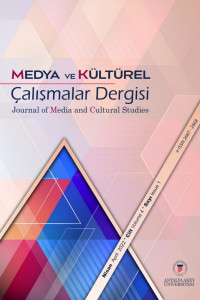Küresel Salgın Döneminde Marka Saygınlık Yönetimi
Saygınlık, İtibar, Küresel Salgın, Göstergebilim, Marka
BRAND RESPECT MANAGEMENT IN THE PANDEMIC PERIOD
Brand, Reputation, Pandemic, Value, Semiotics,
___
- • Alsop, R. J. (2004). Immutable Laws of Corporate Reputation, NY:Wall Street Journal Book
- • Anca C.E. ve Roderick B. (2007). The Influence of Brand Image and Company Reputation Where Manufacturers Market To Small Firms: A Customer Value Perspective, Industrial Mar- keting Management Journal, 36, 135-137.
- • Barnett M. L., Jermier J. M. ve Lafferty B. A. (2006). Corporate Reputation: The Definitional Landscape. Corporate Reputation Review, 9 (1), 26-38.
- • Bruijns ,C. (2006). Commentary: Should an Organization Devote Communication Dollars to Making the CEO Famous?, Aralık 17, 2006
- • Budd, J. F. (1994). How to Manage Corporate Reputations, Public Relations Quarterly, Volume:39, Number:4., New York, U.S.A.
- • Bulletpoint, (2001). Reputation Management. Building Lustre behind the Name. http://www.bulletpoint.com.
- • Connolly, M. (2002). Reputation Management – a social environmental perspective. http://www.corporatecomm.org.
- • Çağdaş, C. (2001). En Zoru İtibar Yönetimidir.http://www.reklamverenlerdernegi.org.
- • Davies , D. (2006). Managing Your Reputation, Aralık 17, 2006, http://www.dbrc.co.uk /managing %20 your %20 reputation.pdf. • Davies G., Chun R., Da Silva, R.V. ve Poper S. (2003) Corporate Reputation and Competitive- ness, Routledge, New York. www.praxis.massey.ac.nz/fileadmin/praxis/ files/n journal_ files/ıssue1/ commery _
- • Deephouse, D. L. (2000). Media reputation as a strategic resource: An integration of mass communication and resource-based theories. Journal of Management, 26, 1091-1112.
- • Foburn C. J., (1996). Reputation: Realizing Value from the Corporate Image, Boston, Massachusett: Harvard Business School Press,
- • Gray, E. R. ve Balmer, J. M. T. (1998). Managing corporate image and corporate reputation. Long Range Planning, 31(5), 695-702.
- • Güzelcik,-Ural, E. (2002). İtibar Yönetimi Değer Yaratan bir Halkla İlişkiler çalışması Olarak İtibar Yönetimi, İstanbul Ticaret Odası Dergisi, 2002 http://88.255.149.215/xmlui/bitstream/handle/11467/206/M00025.pdf?sequence=1&isAllowed=y
- • Güzelcik-Ural, E. (2006). Stratejik Halkla İlişkiler Uygulamaları, Birsen Yayınevi, İstanbul.
- • https://www.youtube.com/user/turkcell/videos (Turkcell’in Youtube sayfası). Erişim Tarihi: 04.04.2020
- • https://www.youtube.com/user/VakifbankHaber/videos (Vakıfbank’ın Youtube Sayfası) Erişim Tarihi:10.04.2020
- • https://www.youtube.com/user/turkiyeisbankasi/videos (İş Bankası Youtube Kanalı) Erişim Tarihi: 12.04.2020
- • https://www.youtube.com/channel/UCsWJidE1WhRVJPwP0zOgEtw (Koç Holding Youtube Kanalı) Erişim Tarihi:12.04.2020
- • https://www.youtube.com/user/Trendyol/videos (Trendyol Youtube kanalı) Erişim Tarihi:04.04.2020
- • https://www.youtube.com/user/yemeksepeti/videos (Yemeksepeti Youtube Kanalı) 12.04.2020
- • https://www.youtube.com/user/ModaVakkodur/videos (Vakko’nun Youtube Kanalı) Erişim Tarihi:14.04.2020
- • https://www.youtube.com/user/ronesansholding1/videos (Rönesans Holding Youtube Sayfası) Erişim Tarihi:14.04.2020
- • https://www.youtube.com/user/TheSabanciholding/videos (Sabancı Holding Youtube Kanalı) Erişim Tarihi:14.04.2020
- • https://www.youtube.com/user/TURKISHAIRLINES/videos (Türk Hava YollarYoutube Kanalı) Erişim Tarihi:14.04.2020
- • https://mediacat.com/fast-food-markalarindan-saglik-calisanlarina-destek-akimi/ Erişim Tarihi:14.04.2020
- • https://www.sozcu.com.tr/2020/ekonomi/corona-ile-mucadeleye-hangi-sirket-nasil-destek-oldu-5715668/ SOZCU.COM.TR Yayınlanma: 15:02 - 31 Mart 2020 Güncellenme: 19:09 - 31 Mart 2020
- • https://www.uludagsozluk.com/k/erkek-sözü/ (sempatik değil ama yakışıklı) Erişim Tarihi: 14.04.2020
- • Kadıbeşgil S., (2006). İtibar Yönetimi, MediaCat Yayınları, 2. Baskı, İstanbul • Püsküllüoğlu, A.(2015). Türkçe Sözlük, Arkadaş yayıncılık, Ankara
- • TDK, (1992). Türkçe Sözlük. İstanbul: Milliyet Yayınları.
- • Rosson, P., Gassman, H.(2002). Who Are We Now? M&As and Corporate Visual Identity Choice, Erişim: 16.08.2005, http://cibs.management.dal.ca/a013-papers/DP-195.pdf.
- • Sherman, M. L. (1999). Reputation: rhetoric versus reality. London Published for the Institute of Directors and AIG Europe (UK).
- • Turnbull, P. L. (2001). Corporate Social Resposibility and Reputation, Canadian Cooperative Association National Congress, Saint John, NB, Canada.
- • Uzunoğlu, E.; Öksüz, B. (2002). Kurumsal İtibar Riski Yönetimi, 112-123 http://acikerisimarsiv.selcuk.edu.tr:8080/xmlui/bitstream/handle/123456789/12559/Ebru%20UZUNOĞLU%2C-Burcu%20ÖKSÜZ.pdf?sequence=1&isAllowed=ypaper3. pdf.
- • Weiss, A.M., Anderson, A., Macinnes, D. J. (1999). Reputation management as a motivation for sales structure decisions. Journal of Marketing, 63(4), 74−89.
- Yayın Aralığı: Yılda 2 Sayı
- Başlangıç: 2019
- Yayıncı: Antalya Akev Üniversitesi
Sosyal Medyada Trol Hesaplar ve Algı Yönetimi: COVID-19 Sürecinde Twitter’da Aşı Karşıtlığı
Geleneksel Gelin Algısının Medyadaki Temsili ve Dönüşümü “Gelin Evi” Örneği
Televizyon Ekranlarında Reyting Faktörünün Prime Time Kuşağı Yapımlara Yansıması
Sappho- Rosetti-Willams’ den Lirik Temsiller ve Kompozisyonlar
Tek Mekanda Gözetim, Sorgulama ve Hüküm: Netflix Dizisi Criminal (2019-)
Cüneyt BOZKURT, Emir Orhan KILIÇ
Küresel Salgın Döneminde Marka Saygınlık Yönetimi
Serap BOZKURT, Nüket GÜZ, İrem AYAN
Antalya İlinin Coğrafi İşaret Almış Gastronomik Ürünlerinin Değerlendirilmesi
